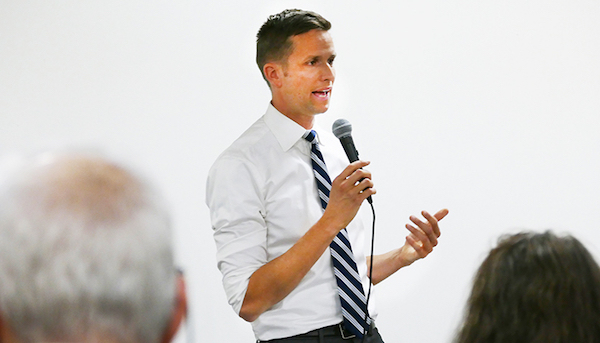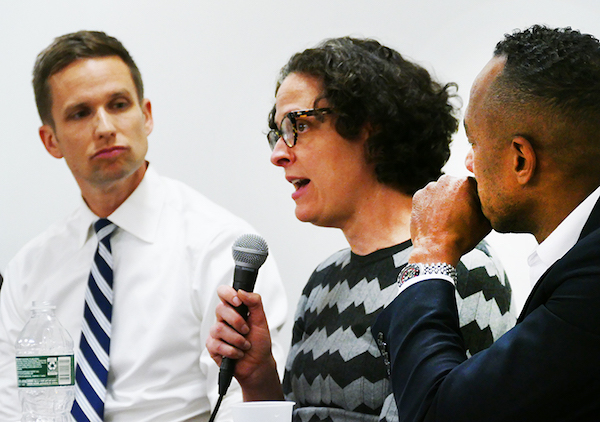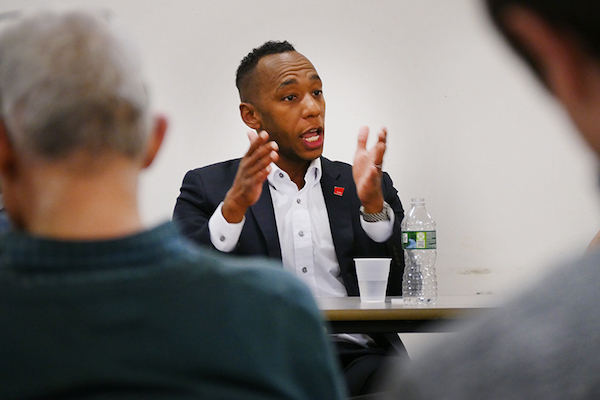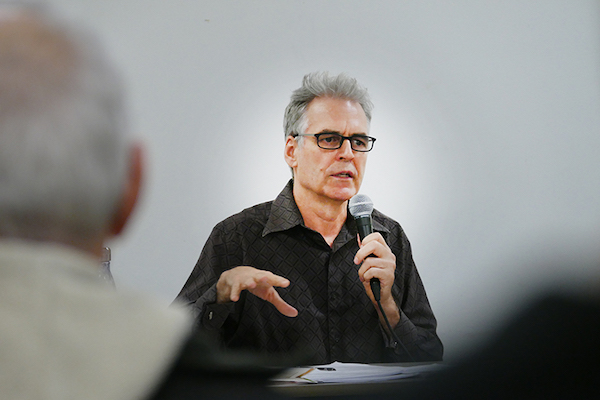
BY DONATHAN SALKALN | As developers re-envision Chelsea and the rest of New York City as an architectural wonderland, attracting well-to-do residents and families, along with many foreign investors, there is one eye-sore that is hard to erase from their blueprints—the homeless.
“Homelessness went up 23 percent under Rudolph Giuliani. It went up another 70 percent under Michael Bloomberg and it’s gone up, I believe, another 40 percent under Bill de Blasio,” said Erik Bottcher, Chief of Staff to New York City Council Speaker Corey Johnson, at a Nov. 21 symposium held by the Chelsea Reform Democratic Club (CRDC), called Homeless: Challenges, Choices and Crises.
The event, held at the Hudson Guild Elliott Center, was moderated by Democratic State Committeewoman Francine Haselkorn, and also included front line homeless advocates Jessica Yager, Vice President of Policy and Planning for Women In Need (WIN), Doug James, General Council for the Center for Urban Community Services (CUCS), and John Mudd, president of the Midtown South Community Council (MSCC).
Said Bottcher, “Most people identify homelessness with the street homeless population, and there were about 3,500 people that slept on the streets and subways last night. In the shelter system and the transitional housing system, there are an additional 79,000 people.”
Yager added that there are additional homeless running under the radar —those being children. She referred to a 2019 survey by Advocates For Children of New York (AFC) reported 114,000 NYC’s students were homeless, either living in shelters (34,000) or with extended family or friends (73,750). The survey also reported that over two thirds of New York City students who are homeless do not read proficiently, and 85 percent of homeless children are black or Hispanic.

Homeless in Chelsea: Safe Haven To Open in Fall 2020
There are many homeless living in Chelsea, be it in parks or niches of shelter, such as under the many scaffolds. These street people refuse to be part of the homeless shelter system, in some cases because they’ve been to the shelters and either feel unsafe in them, the rules are too institutionalized (like jail), or they are struggling with mental or substance abuse challenges.
Bottcher spoke of the phones in Speaker Johnson’s office ringing off the hook, with complaints about the homeless and public safety issues in Chelsea. “We need to be compassionate in getting these people the help they need while also addressing the quality of life issues in insuring that our neighborhoods are safe and clean,” said Bottcher, adding, “The homeless are more likely to be the victim of crime.”
As for removing the chronic homeless from Chelsea’s streets, Bottcher said, “There’s a problem in asking the homeless to come to the Bellevue Intake Center on 30th Street and First Avenue and spend the night sitting in a chair or something, and then going to Randall’s Island or Brooklyn or the Bronx to get into a large shelter— that’s not realistic.” Botcher added, “The average length of stay in the shelter is over 500 days. Those are people waiting for housing to be built.”
The city has instituted a “Safe Haven” model that the Bowery Residents’ Committee (BRC) has effectively used in getting the homeless off the streets. It calls for smaller shelters located in nearby communities that bring the homeless to a facility with fewer rules than city-wide shelters, yet have in-house professionals that address their needs. The Safe Haven plan has been replicated throughout New York City, and today provides over 1,800 beds to men and women in need of individual support.
Said Bottcher, “The Safe Haven is an opportunity to go to those folks and say ‘A few blocks away there’s a place where you can get food, a shower, rest, and even a bed in a room with a door that locks.’ That’s the golden opportunity to get them mental health treatment and substance abuse treatment.”
Bottcher explained of a new Safe Haven for the homeless, to open at 114 W. 14th St. in the fall of 2020. “The city has financed the construction of this Safe Haven. This will get the help the homeless need in the community that they call home.”
The Center for Urban Community will run the new Safe Haven facility. Doug James explained the many facets CUCS, an organization that provides support, including case management and on-site medical and psychiatric services to individuals and families in more than 2,200 supportive housing units in Brooklyn, Manhattan, and the Bronx.
“Outreach workers employed by CUCS, Goddard Riverside, and Breaking Ground from the Manhattan Outreach Consortium are on the street 24 hours a day to meet with, engage, and try to provide services to the street homeless New Yorkers,” noted James, who explained that the organization includes an outreach team made up of doctors, psychiatrists, and nurse practitioners that make non-house calls, often going into parks and encampments with their medical backpacks to help the homeless. CUCS has also designed and employs a highly technical van that handles mobile patient examinations.

James added, “We develop 100 percent affordable housing with 60 percent set aside for the formally homeless and 40 percent for not homeless and with no special needs, such as The Times Square (255 W. 43rd St.) and The Prince George (14 E. 28th St.), which we run in conjunction with Breaking Ground.”
CUCS is also proactive in keeping people from becoming homeless. Said James, “We also run Benefit Coordination Centers where you can get connected to all the different benefits, legal assistance, and anti-eviction legal services to prevent people from entering the shelter system.”
Loss of Chelsea Affordable Housing: SROs
Chelsea once had a wealth of single-room occupancy (SRO) housing —mostly for sailors, dock workers, and low wage workers, back when the Hudson Piers were laded with cargo and liners. After the docks closed, one by one, Chelsea’s SROs were converted to market rate housing.
Said Yager, “SROs used to be an important source of housing for people of low income, and they basically don’t exist anymore,”
This past July, three SROs were condemned by the City (219, 221, 223 W. 24th St). According to a July 8, 2019 Daily News article titled Manhattan boro prez chides city over shutdown of 3 affordable housing buildings, “Borough President Gale Brewer cited a year-old Department of Buildings directive to repair rotting joists in one of the buildings and pointed to the city’s ‘lack of timely enforcement’ as the reason why tenants were forced out.”
Meanwhile, SRO residents in the Chelsea Hotel to this day are fighting for the right to live in their rooms. Amidst nearly a decade of renovations, SRO residents are dwindling in numbers, but a few are adamant in not giving up their 220 square feet that they love, and call home.
A 2013 study by City University of New York Law Review stated that single-room occupancy (SRO) housing once dominated the New York City housing market. “As recently as the mid-twentieth century, there were hundreds of thousands of SROs spread throughout the City. Today, following a half-century of concerted attacks by city government, SROs constitute a fraction of a single percent of New York’s rental housing stock. The City’s decimation of SRO housing has amplified the ongoing housing crisis, constricting the low-income housing market and contributing to the ballooning homelessness problem. If City and State are serious about confronting New York City’s housing crisis, existing SRO policies need to be changed and their legacy confronted. City and State must take steps to permit and encourage the expansion of the SRO housing stock.”

Homeless in Midtown: Working Together
The meeting was treated to a piece of Midtown community history. John Mudd, 30 years as president of Midtown South Community Council, told of his organization’s challenges in addressing the quality of life concerns of its residents and local businesses, while coordinating those issues with the NYPD, in an area that includes Times Square, The Port Authority, and Penn Station. These are places where homeless don’t dress up as super heroes.
Mudd spoke of the overwhelming commercialization of Midtown, lamenting on the many new hotels. He invited everyone to visit his blog on the MSCC website, where he wrote on Dec. 20 (in a piece originally published by Chelsea Community News), “Labeling the 42nd Street and Times Square transformations—from the historically grungy haven of porn, dope, and prostitution of the 1980s, to the jam-packed Disneyfied commercial bonanza of today—as ‘progressive’ may be debatable, but the financial windfall these locales have garnered is undeniable, by their overwhelming hordes of shoppers, diners, and theater-goers.”
“We all work in silos.” Mudd said, referring to all the different organizations that battle homelessness. “By networking and working together we all communicate. Having monthly meetings with the residents, Police Department, the Councilor’s office, the city, religious groups, and homeless care services, we are building a community of care.”
Mudd spoke of a need for the homeless who have health issues. “New York City does not have medical respite beds. When you have the homeless going to the hospital and no place to leave to, other than back to the streets, they are only going to return the hospital. It creates a cycle.” Mudd told the group of how he and others others went to Boston to visit their respite bed facility. “They’re willing to help us in understanding the costs and what it would take to build one,” Mudd said.
“We are also developing ‘street sheets’ for the homeless —where to find shelter, where to find food, and where to find services,” Mudd noted.
During Q&A, CRDC past president and current Community Board 4 member David Warren asked the panel about programs that do laundry for homeless students (who well might be negatively labeled at school by other students). Evelyn Suerez, CRDC’s Vice President of Outreach, has been trying to get a program to get laundry aid to the Chelsea’s homeless students, but has been met with resistance. Due to an abbreviated Q&A period the meeting didn’t hear of MSCC’s Laundry For Kids Program. After the meeting, Mudd related what his organization is doing for local homeless children during such a precious period of their lives.
“We have Laundry for Kids program having served close to 300 families.” Mudd said. “The MSCC program builds confidence and overall well being for young children who need clean clothes to wear in school. Access to clean clothing has proven to reduce stigmatism and absenteeism for homeless students. We are in our third year.”
“We’ve tried to open a laundry facility at an old NYCHA facility but it has been stalled. We approached some schools about adding a laundry facility which has gone no where. We’re still looking to install laundry facilities in churches, schools, or community spaces.” Mudd added, noting all donations go to laundry vouchers to be used at participating laundromats in Midtown Manhattan.

City Wide Homelessness: The Big Squeeze
According to a 2014 U.S. Census estimate 8.5 million people are living in the city —up from 7.3 million in 1990, with the bulk of these new residents being immigrants. In 2013, the population of foreign-born individuals living in New York City had increased to 3.07 million and, as 36 percent of total population, was the highest it had been in the past 100 years. These hard working new New Yorkers aren’t all customers of luxury and market rate housing, so it is no wonder there is a supply and demand crisis for affordable housing. With new developments built on the back of city tax breaks, with 70 percent market-rate apartments combined with 30 percent affordable units, it is comparable to a lopsided football score, where 70-30 is in favor of the rich and does little to address the numbers of new immigrant residents, and others struggling to survive.
Yager, who’s WIN organization is the largest provider of homeless family housing in NYC, has found the market for moving families into affordable housing a dead end. While applauding Mayor de Blasio’s rental assistance program, CITYFEPS, she feels the program needs a reality check. “The city has created a rental voucher because there are very few new Federal Section 8 vouchers being issued. The city has now its own program, but it doesn’t pay enough,” Yager said.
Rental vouchers vary according to family size, but amounts to $1,515 a month for a family of four. Yeager pointed out, “Out of the people that moved out of shelters and had access to a voucher, only twenty-eight percent used that voucher.” WIN has been advocating that the NYC Council to raise the CITYFEPS voucher rental amounts.
It’s gotten so dire that Mayor de Blasio’s Special One Time Assistance program (SOTA) has been sending the city’s homeless out of state in a similar way it exports garbage to landfills in New Jersey, Pennsylvania, and Virginia. The City of Newark, NJ has lodged a lawsuit against NYC for sending 1,198 families to their municipality, and only paying for their first year of rent. An ordinance was recently passed in Newark essentially banning any type of rental for which someone pays a full year of rent up front.
Said Chelsea’s own Christine Quinn, former Council Speaker and WIN’s current President and CEO, on a WPIX broadcast this past October, “The homeless crisis and the affordability crisis are two sides of the same coin, but no one will embrace this at the government level.”
Chelsea Community News is made possible with the help of our awesome advertisers, and the support of our readers. If you like what you see, please consider taking part in our GoFundMe campaign (click here). To make a direct donation, give feedback about the site, or send a Letter to The Editor, email us at Scott@chelseacommunitynews.com.

Pingback: กระเบื้องปูพื้น ภายนอก
Pingback: 789bet
Pingback: สอนภาษาไทยให้ชาวต่างชาติ
Pingback: Nexus Market
Pingback: สูตรหวย ใช้งานง่าย คำนวณแม่น อัพเดทปี 2024
Pingback: ....
Pingback: เกียรติบัตรออนไลน์
Pingback: lucabet เว็บตรง
Pingback: Buy Pini Kay Briquettes Online
Pingback: hanongnong
Pingback: Buy M249 / M249S CLEANING KIT WITH GAUGES Online
Pingback: รับเหมาแรงงาน
Pingback: ผู้ป่วยติดเตียง
Pingback: บุหรี่นอก
Pingback: นำเข้าสินค้าจากจีน
Pingback: blote tieten
Pingback: วิเคราะห์ ฟุตบอลเต็งวันนี้
Pingback: แก้หนังตาตก พระราม 9
Pingback: ทางเข้า lsm99
Pingback: ทีเด็ดฟุตบอล
Pingback: Buy Vape carts online
Pingback: Full Posting
Pingback: hk pistols
Pingback: look at this website
Pingback: Lyophilized Goldmember Magic Mushrooms
Pingback: Plantation Shutters
Pingback: read here
Pingback: you could try this out